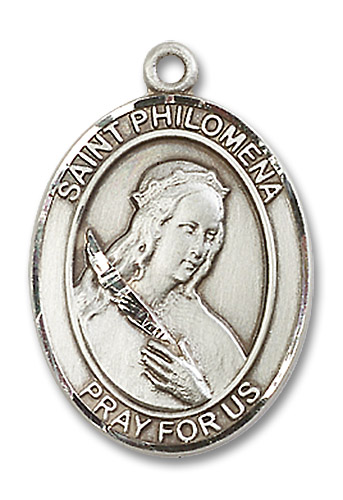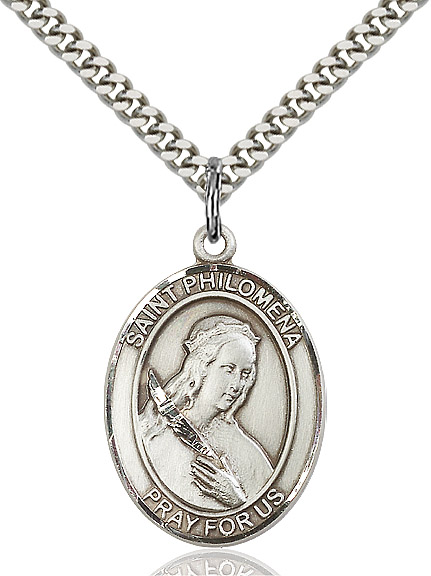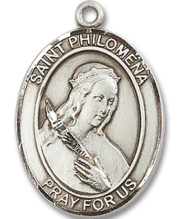$58.99 – $1,254.00
St. Philomena Medal
- St. Philomena is the patron saint of infants, babies, youth, priests, the imprisoned, young married couples, and distressed mothers.
- St. Philomena’s feast day is celebrated on August 11th.
This St. Philomena medal has been proudly hand-made for over a century by Bliss’ team of artists in Rhode Island. The St. Philomena medal is crafted to last a lifetime.
St. Philomena Medal
This St. Philomena Medal and Necklace features a pendant with a hand pressed image of St. Philomena surrounded by the words ‘St. Philomena Pray for Us’.
Sterling Silver St. Philomena Medal and Necklace
14KT Gold Filled St. Philomena Medal and Necklace
14KT Gold St Philomena Medal
St. Philomena
Who is the Patron Saint of the Children of Mary?
There is no record of the earthly life of St. Philomena. Her remains were accidentally discovered in 1802 in an underground cemetery on the road from Rome to Ancona as excavators were clearing away some fallen sand. The burial stone bore the symbols indicating virginity and martyrdom-a lily, a spear, and an anchor. The three words over the tomb bore the inscription LUMENA PAX CUM FI, which when correctly arranged would read: PAX TECUM FILUMENA-“Peace be to you, Philomena”.
No Known Record of Her Life
It was the power of her intercession-the many marvellus miracles performed-rather than the knowledge of any details of her life, that influenced the Holy See in declaring Philomena a saint. Don Francesco, parish Priest at Mugnano, Italy, desirous of obtaining a relic of a Saint, while in Rome went to the Treasure House of Relics. He selected those of Saint Philomena-the young Virgin-Martyr, and they were enshrined near the Gospel side of the High Altar in the church at Mugnano on August 11, 1805.
Miracles too numerous to mention have occurred since that memorable day Pauline Jaricot, who lived in the southern part of France and was the foundress of the Society of the Propagation of the Faith, in 1819 was seriously ill. She made a pilgrimage to St. Philomena’s shrine in Mugnano and was cured. Enroute she had stopped in Rome to have an audience with Pope Gregory XVI. Too ill to do so, the Holy Father came to see her. Present were Mother Barat and Cardinal Lambruschini. Pauline made the following request of His Holiness: “If on my return from Mugnano I were to come to the Vatican on foot, then would Your Holiness deign to proceed without delay to the final inquiry into the cause of Philomena? “That I can agree to without giving it a thought”, he replied, “for that would be a miracle of the first order.”
Turning to Mother Barat, he said in Italian: “How ill she is! It seems to me as if she had come forth from the grave. We shall never see her again. She will never return”. For several weeks Pauline lingered on, then suddenly regained sufficient strength to continue her journey. Finally she reached Mugnano, and Pauline Jaricot was cured. On her return trip to France she visited the Pope at the Vatican. Convinced that a miracle had been performed, Gregory XVI requested the Sacred Congregation of Rites to debate whether or not a Decree should be promulgated authorizing the public cultus of St. Philomena. The reply was affirmative.
The Decree, authorizing the devotion, and granting to the clergy of Nola (the diocese in which Mugnano is situated) the privilege of celebrating Mass in her honor, was published by Gregory XVI on January 30, 1837. St. Philomena’s feast is celebrated on August 11th in commemoration of the translation of her relics from Rome to Mugnano. In 1849 Pius IX named St. Philomena Patroness of the Children of Mary. Pope Saint Pius X and Saint John Mary Vianney both held St. Philomena in the highest esteem.
St. Philomena Rosary
UPC: 617759440454
Brand: Bliss
| Metal Finishing | |
|---|---|
| Size |
Be the first to review “St. Philomena Medal and Necklace” Cancel reply
You must be logged in to post a review.





Reviews
There are no reviews yet.